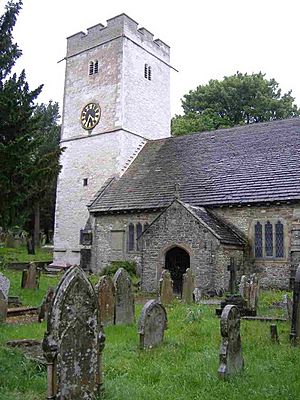St Catwg's Church, Gelligaer facts for kids
Quick facts for kids St Catwg's, Gelligaer |
|
|---|---|
 |
|
| 51°39′52″N 3°15′04″W / 51.6645°N 3.2512°W | |
| Denomination | Anglican |
| History | |
| Status | Active |
| Founded | c. 6th century |
| Dedication | Cadoc |
| Architecture | |
| Functional status | Parish Church |
| Heritage designation | Grade II |
| Designated | 18 July 2001 |
| Specifications | |
| Materials | stone |
| Bells | 1 |
| Administration | |
| Parish | Gelligaer |
| Deanery | Merthyr Tydfil & Caerphilly |
| Archdeaconry | Morgannwg |
| Diocese | Llandaff |
St Catwg's Church in Gelligaer, Caerphilly, is an important old building in South Wales. It is a special place of worship that has been officially listed as a Grade II heritage site. This means it is protected because of its historical and architectural importance.
Contents
A Look Back in Time: The Church's History
The area where St Catwg's Church stands was once a Roman fort. It is believed that Cadoc, a Welsh saint, was born here around the year 500 AD. Cadoc's mother was named Gwladys. There are still remains of a small chapel, called 'Capel Gwladys', which Cadoc is thought to have used around 530 AD.
How the Church Began
The exact date when St Catwg's Church was first built is not known. However, it is thought to have been founded in 1266. This was when the Normans took control of the local area. Sadly, many early records of the church have been lost over time.
Gifts from the Tudors
Later, in 1488, a special gift was made to the church. Jasper Tudor, Duke of Bedford, who was the uncle of King Henry VII of England, lived in Cardiff Castle. He gave a set of bells and an organ to St Catwg's Church. This was to thank the people of Glamorgan for supporting the Tudor family. St Catwg's was one of eight churches in the area to receive such gifts. Even Llandaff Cathedral received a new tower. These bells and the organ stayed with the church until the time of the Commonwealth of England (a period when England was ruled without a king).
Changes During the Reformation
During the Reformation (a time of big changes in the church), St Catwg's lost many of its valuable items. More church records were also lost. For a while, many people in Gelligaer continued to follow the old ways of the church, which meant they supported the Pope. Some people were even called to court in 1622 for not attending the new church services.
Challenges and Repairs
The church faced some tough times. For example, a rector (the main priest) was removed during the Commonwealth period for not agreeing with new church rules. For ten years after that, the church did not have a steady priest. Gelligaer was a wealthy area for the church. However, this sometimes meant that priests who were given the job did not always live in the area or care much about the local people.
One such priest, Thomas Stacy, was rector from 1827 to 1861. But he spent most of his time in Llandaff. Because of this, the church building started to fall apart. In September 1866, the church's roof even collapsed! It was repaired by an architect named Charles Buckeridge in 1867-1868. Later, in 1903, the plaster inside the church was removed. In 1931, a new room for the priests (called a vestry) was added. The old vestry became a special chapel for the Virgin Mary, known as a lady chapel. St Catwg's Church was officially listed as a heritage building in 2001.
New Churches: St Catwg's Family Grows
St Catwg's Church used to be part of a very large parish. A parish is like a church district. This parish covered a big part of North Eastern Glamorgan. In the 1800s, more and more factories and mines were built. This caused the population to grow a lot. Because of this, the large parish was divided into smaller ones. St Catwg's later had two "daughter churches" built to serve the growing communities. Neither of these daughter churches are listed as heritage sites.
St Margaret's Church, Gilfach
St Margaret's in Gilfach started as a small mission in 1895. A small wooden church was built in 1903. Later, a metal church, sometimes called a tin tabernacle, was put up at its current spot. This metal church then became a church hall. The current St Margaret's Church was finished next to it and opened on November 29, 1933. Both the wooden church and the metal church have since been taken down.
St Anne's Church, Cefn Hengoed
St Anne's in Cefn Hengoed began in 1931. A new church building, St Anne's church, was completed in 1939. This church served the community for many years. It stopped operating in the early 2010s.
Images for kids



